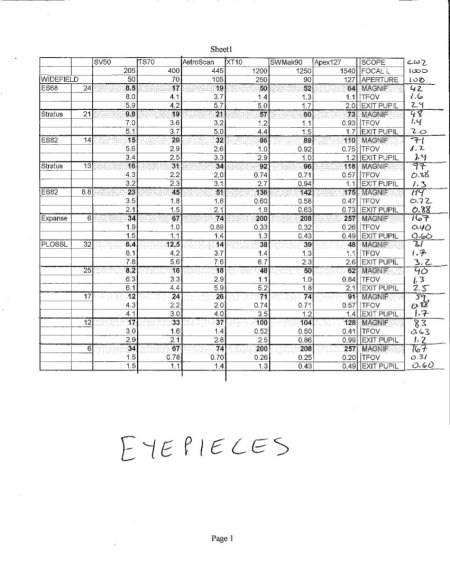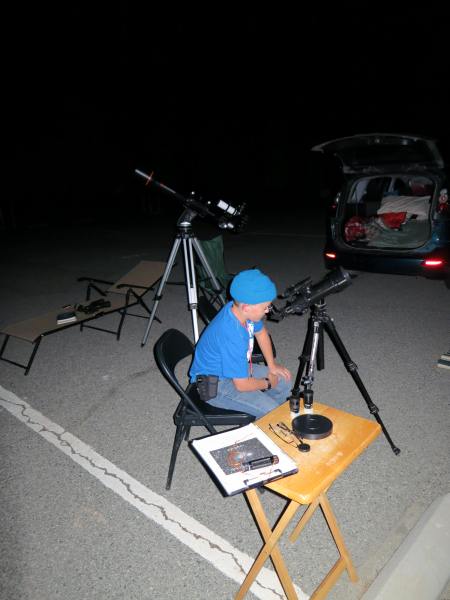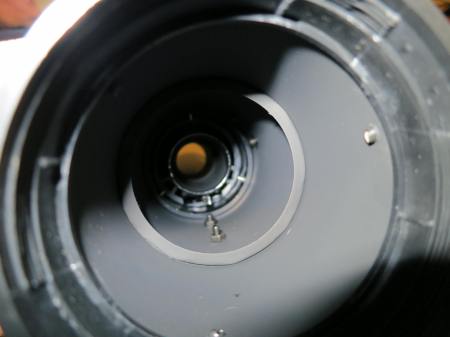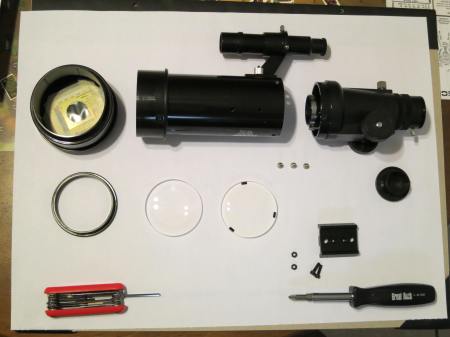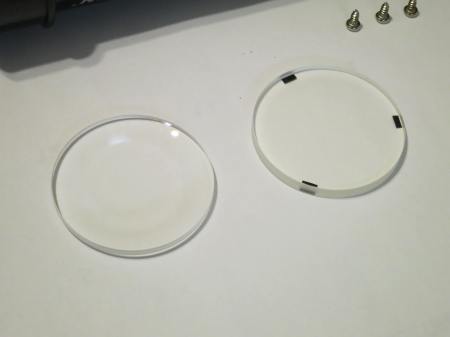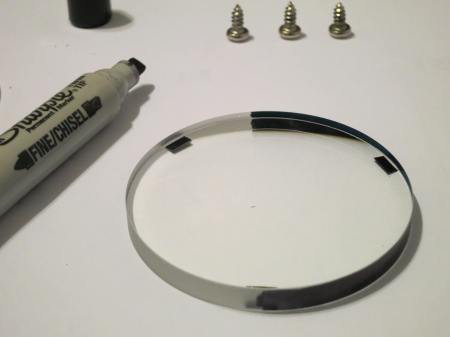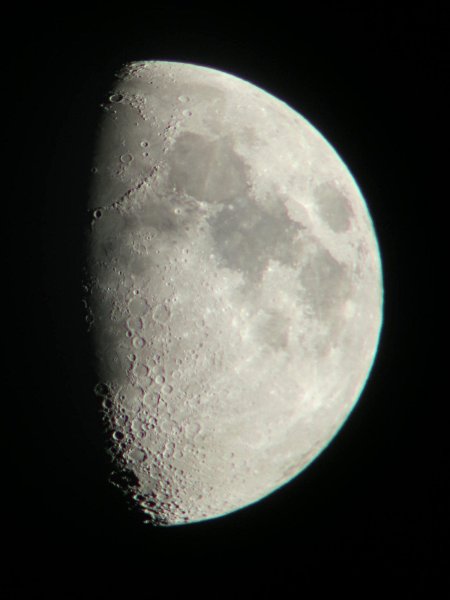
London and I were back at the Salton Sea this past Saturday night (Oct. 12-13). It was our first time there since my accidental Messier Marathon back in March. In between times it has been too darned hot to go camping in the desert. It was good to be back.

The big news was that I was rolling with a new scope: a Celestron C102 f/10 achromatic refractor, one of the “screaming deal” scopes from this post. I put it on the SkyWatcher AZ4 (= Orion VersaGo II ) alt-az mount where my Apex 127 Mak usually rides. The included dovetail on this scope is too small and too far forward to balance well with an optical finder and heavy eyepieces, so I sprung for the Explore Scientific tube rings and dovetail kit. That was a pretty darned good deal; tube rings alone for a 4-inch scope run $30-40, and a decent-length dovetail is another $15-20, but the ES kit has both for $45, plus a very convenient carry handle opposite the dovetail bar. With the rings in place I could mount my StellarVue SV50 as a finder, and I was ready to go.
) alt-az mount where my Apex 127 Mak usually rides. The included dovetail on this scope is too small and too far forward to balance well with an optical finder and heavy eyepieces, so I sprung for the Explore Scientific tube rings and dovetail kit. That was a pretty darned good deal; tube rings alone for a 4-inch scope run $30-40, and a decent-length dovetail is another $15-20, but the ES kit has both for $45, plus a very convenient carry handle opposite the dovetail bar. With the rings in place I could mount my StellarVue SV50 as a finder, and I was ready to go.

I also brought along the Apex 127 in case I felt like a change of pace, and because it takes up almost no room (which is one of the reasons I got it in the first place). But I was having too much fun with the C102 and the Apex 127 never made it out of the case. At some point I’ll have to do a detailed comparo between the two scopes, but Saturday night I was just out to have a good time.
We also had along the Celestron Travel Scope 70, which London is using in the photo above. I had completely disassembled and reassembled that scope, and after London went to bed at 10:00 I divided my time about equally between the C102 and TS70. Partly I wanted to put both scopes through their paces, and partly I just wanted to hop around the sky, checking in on friends new and old.

I will have to do a full-on review of the C102 at some point. For now, suffice it to say that it is a very nice scope. Image brightness and contrast are both excellent; for someone who has spent most of his time observing with reflectors and catadioptrics, this does not feel like a 4-inch scope. On most objects I could have been fooled into thinking I was looking through a 5- or even 6-inch mirror scope.
Grain of salt: I didn’t actually go back and forth between this scope and 5- or 6-inch mirror scope, although I plan to do that in the future. I’m just saying that as someone who has spent a lot of time looking through smallish Newts and Maks, this scope felt like it punched above its weight. I was worried that I would feel like I was missing out by taking such a small scope as my main instrument. But I was having so much fun with it that I stayed up nearly to dawn–there were always two or three more things I wanted to check out.
The photo above is not from Saturday night but from my driveway on Friday night, when the moon was exactly at first quarter. I flip-flopped it left to right and lightly sharpened it in GIMP, but didn’t fiddle with the brightness or color. There is some false color, most notably along the limb of the moon and on bright planets like Jupiter, but I didn’t find it objectionable. YMMV.

I think this is my new favorite moon scope. The image is so contrasty, details just pop. I would put in the 6mm Expanse (167x), watch the moon drift across the field of view, and pretend I was an astronaut. I also sketched a really nice catena (crater chain) in the northeast quadrant of the crater Deslandres. You can see it on the right in this LPOD image, opposite the smaller crater Hell that sits in the western part of Deslandres. If this catena has a name, I haven’t discovered it yet; feel free to enlighten me in the comments.
The moon set precisely at 1:00 AM. As you can see from the above composite, the seeing was not fantastic, especially near the horizon. Stars were visibly twinkling below about 45 degrees elevation.
After the moon set, it was like a whole new sky. The Milky way fairly blazed, and the sky was so full of bright stars that it was almost overwhelming. I was about as happy as I have ever been.

I spent some time observing near the zenith. This can be a pain with a long-tube scope like the C102. You can extend the tripod legs to put the eyepiece at a convenient height, but then you’re futzing with tripod legs all night long, which I loathe doing (another reason I got the Apex 127 was that I can go from horizon to zenith at one tripod setting). I remembered David DeLano saying that he often sits on the ground to observe at high angles, and that led to some experimentation. I found that my range of comfortable sitting eyepiece heights overlaps with my comfortable kneeling eyepiece heights, so I put out a camp pad for my knees and a folding chair for my elbows and voila. Someday I will build or buy an adjustable observing chair, but until then, this will do.

I have a couple collapsible camp chairs. They are great for stashing eyepieces when I’m really rolling, because I don’t have to worry about them falling over and rolling off onto the ground like I would with a table. I keep my eyepiece case on a picnic table, well back from the edge, so there’s no real opportunity to knock it over.
Now that I have some nice Explore Scientific widefields, I have become a bit of an eyepiece snob. Early in the evening I was sharing views with London and people from a nearby campsite so I started with my “second string” of Orion Stratuses and Plossls, just in case. Sound like a jerk move? Just wait until some kid–or a grown-up relative, in my case–says, “Hey, do I look here?”, and stabs the eye lens of your favorite eyepiece with a greasy fingertip.
But I guess the joke’s on me because the views through the second string EPs were so good that I never got around to hauling out the ES models. My lineup for Saturday night included:
- 32mm Plossl (31x, 1.7 degree true field of view) for lowest magnification and maximum true field in a 1.25″ EP (I don’t have a 2″ diagonal yet so my 38mm AstroTech Titan, which would go even lower and wider, stayed home);
- 25mm Plossl (40x, 1.3 degrees);
- 21mm Stratus (48x, 1.4 degrees)–comparing this to the 25mm Plossl illustrates one of the nice things about widefields: you can get higher magnification (bigger image scale) and a larger true field (more actual celestial real estate) at the same time;
- 13mm Stratus (77x, 0.88 degrees);
- 12mm Plossl (83x, 0.63 degrees);
- 6mm Expanse (167x, 0.40 degrees).
You would think that the Stratuses would put the 25mm and 12mm Plossls out of business, since they give basically the same or better magnification and a bigger true field. But the Stratuses are quite a bit heavier than the Plossls and required rebalancing the scope. So I was either in Stratus mode or Plossl-and-Expanse mode, and over the course of the evening, the cheap eyepieces won out in terms of convenience.
Also, frankly, f/10 is a pretty forgiving focal ratio. With a light cone that shallow, practically any eyepiece is going to do well. The only reason to prefer widefields is for their actual wide fields, and not to help control aberrations from the scope itself. I did note that the difference in apparent field of view was immediately obvious when I bounced from the 52-degree Plossls to the 68-degree Stratuses. Oddly, I never noticed it with the 6mm Expanse (66 degrees), but I think that’s because I only used the Expanse to power up on the moon, planets, and double stars, where I was always fixated on whatever was at the center of the field.
My favorite observations of the night, in rough chronological order:
Double Cluster and Stock 2
I have waxed poetic about the Double Cluster before (you can find it here). It’s pretty close to a larger, sparser cluster called Stock 2, which is shown is most atlases, including the Pocket Sky Atlas. But I had never noticed the chain of bright stars that connects Stock 2 and the Double Cluster, and I had also not picked up the stick figure in the center of Stock 2. Here’s a photo by Doug Scobel of the University of Michigan Lowbrow Astronomers (borrowed from here) that shows what I mean (lower image GIMPed by me):

I revisited the Double Cluster periodically throughout the night. Right after dark it was the second thing I looked at, after the moon, and it was my last object before I packed up at 5:40 AM. Probably my best view was at 3:00 AM, when I wrote:
Nicely framed, mesmerizingly beautiful. I see at least two red stars in more easterly cluster, NGC 884. NGC 869 is at end of chain to Stock 2. All at 31x.
I still do plan to get into astronomical sketching, and when I do, I reckon the Double Cluster will be one of my first targets, if not my very first.
Andromeda Galaxy (M31) and satellite galaxies (M32 and M110)
Also about 3:00 AM, immediately before the Double Cluster observation above:
With 32mm Plossl (31x), all three galaxies fit in field, with dust lane popping in and out in averted vision.
I should mention that M31 itself was too big to fit into the field of view of my lowest-power eyepiece; with the core of the galaxy centered in the field, the edges of the spiral arms went out of the field in both directions. M31 is so darned big that unless you have an instrument with a 3-degree true field, you just can’t see all of it at once. Corollary: if you can fit the galaxy into a smaller field of view, then you’re not seeing all of it, which is sadly the case under even moderate light pollution. The core will punch through even vile city lights, but the spiral arms just die out.
Jupiter
Best view was at 5:00 AM, with the 12mm Plossl (83x):
Bands not quite lined up with moons. NEB [North Equatorial Belt] seems narrower and better defined than SEB. Several distinct belts to north, single broad ?temperate belt to south. Max detail at this mag–at 187x, seeing is too mushy.
Zodiacal light
I stopped about 5:10 for a biology break. Walking back to the telescope, I was stopped in my tracks by what seemed to be a second Milky Way: a broad band of light stabbing up from the eastern horizon, past Mars and the Beehive (M44) and reaching almost to Jupiter, which was by then high in the sky. It took me a minute to realize that this was the zodiacal light: the cumulative effect of sunlight reflecting off of countless grains of dust in the ecliptic plane of the solar system. The name “zodiacal light” comes from the fact that this light is always found along the zodiacal path traced by the sun, moon, and planets, as it must be, since almost everything in the solar system orbits in roughly the same ecliptic plane (comets excepted–they can come in from any angle, and the fact that they do so was one of the first clues to the existence of the Oort Cloud).
The Gegenschein, which I saw at the 2010 All-Arizona Star Party, is another manifestation of the same phenomenon. Basically, the Gegenschein comes from “full” dust grains exactly opposite the sun in the sky, and the zodiacal light comes from “crescent” or “gibbous” dust grains at other angles. Apparently under the very darkest skies, the Gegenschein can be seen as a bright patch in an arc of zodiacal light that stretches overhead from horizon to horizon. I have not seen that, but it’s on my bucket list.
Anyway, given how bright the zodiacal light was Sunday morning, I think I must have seen it many times before and simply not recognized it. I will keep my eyes peeled in the future.
M81 and M82
Anytime I’ve got more than one bright galaxy in the eyepiece, I’m a happy man. These two were nicely framed in the 32mm Plossl (31x). Using the 12mm Plossl (83x), the gravitationally-tortured M82 showed some hints of detail in averted vision.
The Odd Couple–M97 and M108
Probably my favorite pair of Messier objects. M97, the Owl Nebula, is a planetary nebula, a single dying star, about 2000 light years from Earth–right next door, cosmically speaking. M108 is a spiral galaxy in the Ursa Major galaxy cluster, about 46 million light years away, roughly the same size as the Milky Way and containing perhaps half a trillion stars. So one of these things is 23,000 times farther than the other one, and several hundred billion times more massive. If M97 was a ping-pong ball held at arms length, M108 would be a frisbee half a mile wide, located 8.5 miles away. But they look about the same in the telescope in terms of size and brightness, and you can frame them in the same low-power field of view, as I did at 5:27 AM on Sunday.
(Incidentally, I just discovered that Google will convert megaparsecs to light years–handy!)

After visiting M97 and M108, I had a quick peek at Mars. The red planet is very distant right now, on the opposite side of the sun from us, but it was visibly a disk and not just a point even at low magnification. The disk was most clear at 83x in the 12mm Plossl, but the planet was just flaming in the lousy seeing and I couldn’t make out any details.
Speaking of Mars, our rover Opportunity landed in January, 2004, and is therefore more than nine-and-a-half years into its 90-day mission. Not bad.
After Mars I briefly revisited the Double Cluster, but I could tell that my eyes and brain were no longer operating at anything like peak capacity. So I closed everything down and got a couple of hours of rack. The photo above shows my super-fancy telescope protection system. There are dedicated protective covers for telescopes that will work in rain, sleet, and hail, but hell, if conditions get that bad I will pull the scope inside the car. I didn’t just pack it up because I wanted to do a little birding with it in the morning.
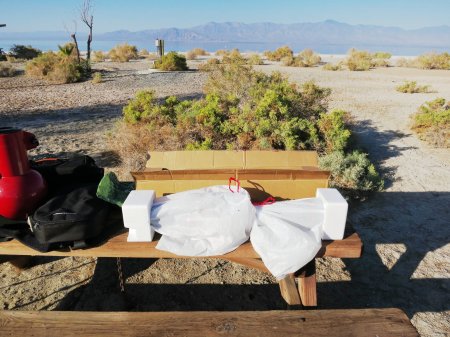
We did spend some time birding, and then while London got the campfire going, I started packing up. I do have a nice padded case for the telescope en route from Amazon–this one , recommended by David DeLano–but it’s not here yet so I used the trash bags and the packing materials the scope came in.
, recommended by David DeLano–but it’s not here yet so I used the trash bags and the packing materials the scope came in.

London stayed busy with the Travel Scope 70, which had gotten a workout overnight on the moon, Jupiter, and the deep sky. I have another post coming about the reborn TS70–stay tuned.

One last thing: Reese’s peanut butter cups make fantastic s’mores, and if you have any left over, they are great in pancakes, too.
All in all, it was a fantastic night, one of my best–and longest–nights of stargazing of all time. At 3:30 I stopped observing to sit at one of the picnic tables and eat a banana. The stars were so bright and the sky was so full of stuff to look at. When I got back to the telescope, I scrawled in my notebook, “Nights like this make me wonder why I bother to observe anywhere else.”
















